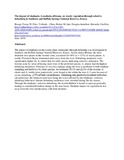| dc.contributor.author | Ihwagi, Festus W | |
| dc.contributor.author | Fritz, Vollrath | |
| dc.contributor.author | . Chira, Robert M | |
| dc.contributor.author | Iain, Douglas-hamilton | |
| dc.contributor.author | Kironchi, Geoffrey | |
| dc.date.accessioned | 2013-06-18T06:23:44Z | |
| dc.date.available | 2013-06-18T06:23:44Z | |
| dc.date.issued | 2010 | |
| dc.identifier.citation | Festus W. Ihwagi1, Fritz Vollrath,robert M. Chira,iain Douglas-hamilton, Geoffrey Kironchi,The impact of elephants, Loxodonta africana, on woody vegetation through selective debarking in Samburu and Buffalo Springs National Reserves, Kenya,African Journal of Ecology Volume 48, Issue 1, pages 87–95, March 2010 | en |
| dc.identifier.uri | http://onlinelibrary.wiley.com/doi/10.1111/j.1365-2028.2009.01089.x/abstract;jsessionid=F9A12D1F4945437C0211A39F5531E8DF.d04t02?deniedAccessCusto | |
| dc.identifier.uri | http://erepository.uonbi.ac.ke:8080/xmlui/handle/123456789/35244 | |
| dc.description.abstract | The impact of elephants on the woody plant community through debarking was investigated in Samburu and Buffalo Springs National Reserves, Kenya. Acacia elatior Brenan, the most abundant tree species in the riverine zone, accounted for 68% (n = 1375) of woody plants. A. tortilis (Forsskal) Hayne dominated plots away from the river. Debarking incidences were significantly higher for A. elatior than for other species indicating selective utilization. The riverine zone by virtue of having more trees of the preferred species, A. elatior, had the highest debarking incidences. Presence of very few saplings along the river is attributed to both elephant trampling and herbivory by other species. An estimated 38.5% and 22.5% of the riverine A. elatior and A. tortilis trees respectively, were bound to die within the next 4–5 years because of severe debarking, ≥75% of bark circumference. Debarking was positively correlated with stem circumference; the medium-sized trees being the worst affected by the elephants’ selective debarking behaviour. Intense debarking incidences were recorded during the dry season. Through the elephants’ selective debarking, the riverine habitat is bound to open up gradually, leading to considerable habitat change in the near future. Elephant impact on vegetation is less away from the river and increases with their densities. | en |
| dc.language.iso | en | en |
| dc.publisher | University of Nairobi, | en |
| dc.subject | Elephants | en |
| dc.subject | Samburu | en |
| dc.subject | selective debarking | en |
| dc.subject | woody plants | en |
| dc.title | The impact of elephants, Loxodonta africana, on woody vegetation through selective debarking in Samburu and Buffalo Springs National Reserves, Kenya | en |
| dc.type | Article | en |
| local.publisher | Department of land resource management and agricultural technology, | en |

